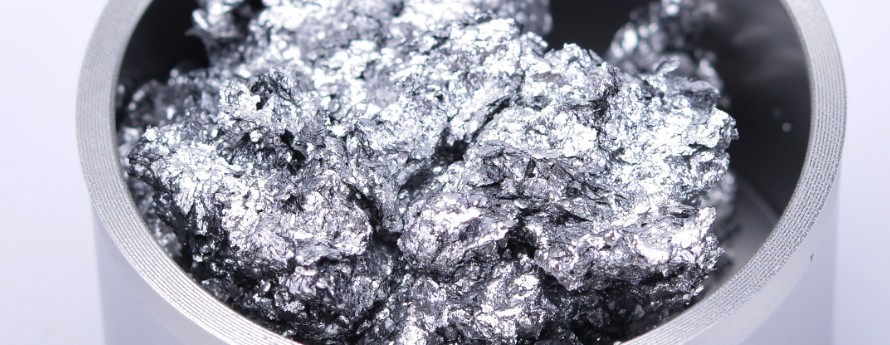
1. What is aluminum silver paste?
Aluminum-silver paste is a kind of inorganic metal pigment, which is
mainly composed of aluminum flakes, solvents and additives. The ratio is
about 60%-70%: 30%-40%:0-10%. After special processing technology and
surface treatment, the surface of the aluminum sheet is smooth and flat,
the edges are neat, the shape is regular, the particle size
distribution is concentrated, and the matching with the coating system
is excellent. The aluminum-silver paste is mainly in the form of paste
or paste, among which the shapes of aluminum flakes are silver dollar,
snowflake and scaly. The industry uses special terms such as solid
content, particle size, whiteness, brightness, metallicity, hiding
power, and cleanliness to describe the physical properties of aluminum
silver paste. The particle state of the aluminum-silver paste is in the
form of scales. In most processes for producing aluminum silver paste,
lubricants are required to prevent "cold welding". When used in
coatings, these lubricants can impart floating or non-floating
characteristics to the aluminum silver paste.
2. Types of aluminum paste and its coating effect
The main raw materials for preparing floating aluminum silver paste are
atomized aluminum powder, solvent oil and stearic acid (saturated fatty
acid, density: 0.847g/cm3). In the ball milling stage, saturated fatty
acids such as stearic acid are used as lubricants. Stearic acid is
adsorbed on the surface of the aluminum sheet to make the aluminum
silver paste hydrophobic and oleophobic. The aluminum flakes coated with
stearic acid in the coating system cannot be wetted by the base
material, and the density is relatively small, thereby reducing the
downward gravity of the aluminum flakes. On the other hand, with the
upward thrust of the molecules moving to the surface of the carrier when
the solvent volatilizes, the sinking force formed by the weight of the
aluminum sheet is offset to make it float to the surface of the paint
film, and an opaque silver film is formed on and near the surface of the
paint film. Since the aluminum flakes float on the surface of the paint
film, and some of the aluminum flakes overlap, there will be silver
drop, and recoating is also difficult. Floating aluminum silver paste is
generally used for roof coating, maintenance, anti-corrosion coatings,
reflective coatings, and imitation chrome-plating effect coatings that
require high protection. Its appearance varies according to the
thickness of the particles (particle size), which can range from rough,
white appearance to gray, highly reflective or mirror-like effects, and
can produce effects from flat, silver, and high-gloss (chrome-plated).
The coarse-grained floating aluminum silver paste has the lowest hiding
power and rough structure, but it can obtain the whitest and brightest
coating. On the contrary, the fine-grained floating aluminum silver
paste has the greatest hiding power, the smoothest structure and high
reflectivity. These floating aluminum silver paste aluminum sheets have a
smooth surface, which can reflect light (visible light, ultraviolet
light and infrared light), and have good heat insulation effects; the
densely laminated aluminum sheets can also provide shielding effects to
prevent moisture and other reaction media from entering the paint film ,
It has a good protective effect on the coating substrate.
②Non-floating aluminum silver paste and its coating effect
The main raw materials for preparing non-floating silver paste (except
electroplating silver) are atomized aluminum powder, solvent oil, and
oleic acid or erucic acid (unsaturated fatty acid). The non-floating
aluminum silver paste uses unsaturated fatty acid as the aluminum sheet
coating material to make the aluminum sheet have lipophilic and
hydrophobic properties, so the aluminum sheet can be completely wetted
by the oily solvent and resin system, evenly distributed in the entire
paint film, and has The tendency of sinking, so the adhesion is very
good, the coating film is firm and stable, and it can be recoated and
finished (see Figure 2 for the effect). Compared with floating aluminum
silver paste, in terms of surface performance, non-floating aluminum
silver paste can provide a more significant improvement and has a very
good decorative effect. It is widely used in vehicles, furniture,
electronic products, coils, etc. Various occasions, automobile paint,
motorcycle paint, bicycle paint, plastic paint, architectural paint,
ink, mobile phone shell and buttons, electromechanical shell, electric
shell, industrial paint and many other fields. Non-floating aluminum
silver paste can also be generally divided into imitation plating, flash
silver, and fine silver. The average particle diameter of fine silver
is the smallest and the brightness is the lowest; the average particle
diameter of flash silver is the largest and the brightness is the
highest; the average particle diameter of imitation electroplated silver
is between fine silver and flash silver, and the brightness is also
between fine silver and flash silver.
There is also a special effect aluminum silver paste in the
non-floating aluminum silver paste, which is electroplated silver.
Electroplating silver is also called mirror silver, mirror aluminum
silver paste, super bright aluminum silver paste or vacuum aluminum
plating suspension. It is not produced by the HALL ball milling method.
It is a non-floating aluminum silver paste produced by using high-purity
aluminum as raw material and using a unique vapor phase metallized
pigment process (VMPs). The aluminum content is 10%-20%, and the average
particle size is The D50 is between 5-12 microns, the thickness of the
aluminum sheet is nanometer, the surface hiding power and brightness are
great, and the excellent electroplating effect or mirror effect can be
obtained with a small amount.
Electroplating silver can replace electroplating, with little harm,
good hiding power and simple construction. It is widely used in paint
(cosmetic bottle paint, wine bottle paint, plastic paint, car paint) and
printing ink (home improvement glass mirror ink, home appliance glass
mirror ink, Mobile phone lens mirror ink, gravure printing ink for
tobacco and alcohol packages) and many other industries.
3. Precautions for storage of aluminum silver paste
Store in an airtight tank indoors at a storage temperature of 15-40°C
(special attention should be paid in winter or when the ambient
temperature is equal to or lower than 10°C). Avoid direct exposure to
sunlight, rain, or high temperatures; excessive jolts and vibrations
during transportation, and storage under certain conditions may cause
partial separation of aluminum and solvent components. Once it is
unpacked and used, it should be used up as soon as possible. If it
cannot be used up at one time, it should be completely sealed
immediately to prevent the solvent in the aluminum-silver paste from
evaporating. If it is left for too long, please test before use.

What is aluminum silver powder?
Aluminum-silver powder is a deep-processed product of aluminum-silver
paste. It is divided into powder metal pigments produced by dry ball
milling process and wet ball milling and coating treatment process, with
stable quality and excellent weather resistance. Generally, it is
mainly used for thermosetting powder coatings (thermosetting refers to
heating and solidification molding without changing the chemical
structure, and cannot be reversed after molding), outdoor decoration
products, plastic masterbatch and some ink products. The solid content
of aluminum silver powder is very high, so the added amount in the
terminal application is relatively low, from 0.5% to 3% of the added
amount.

What is a silver bar?
Silver bars are mainly used to solidify and strip the paste-like
aluminum silver paste to make it more suitable for the application of
end products, such as high-end inks, injection molding, and color
masterbatches. The principle is very similar to the color masterbatch.
They are all carrier pigments made of aluminum silver paste plus soluble
resin or PE wax and a small amount of additives. Silver bar products
have five major advantages: very few bad odors, safe and environmentally
friendly; good stability, can be stored for a long time; easier to
disperse; almost no solvent, rarely incompatibility with plastic or ink
systems; safe transportation.
Aluminum pigments also have more extended products, such as
environmentally friendly aluminum silver paste, odorless aluminum silver
paste, water-based aluminum silver paste, resin-coated aluminum silver
paste, colored aluminum silver paste, nano-aluminum silver paste and so
on.
Sunflower Aluminum Pigment, Sunflower Chemical Group, Sunflower aluminum paste, Sunflower aluminum powder.

